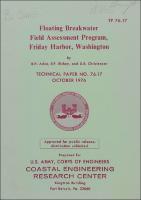Please use this identifier to cite or link to this item:
https://hdl.handle.net/11681/25658Full metadata record
| DC Field | Value | Language |
|---|---|---|
| dc.contributor.author | Adee, Bruce H. | - |
| dc.contributor.author | Richey, Eugene P. | - |
| dc.contributor.author | Christensen, Derald | - |
| dc.date.accessioned | 2017-11-29T22:53:27Z | - |
| dc.date.available | 2017-11-29T22:53:27Z | - |
| dc.date.issued | 1976-10 | - |
| dc.identifier.uri | http://hdl.handle.net/11681/25658 | - |
| dc.description | Technical Paper | en_US |
| dc.description.abstract | A theoretical model for predicting the dynamic behavior of a floating break water is presented along with a report on a field experiment designed to provide basic data for verifying the model. Additional data were taken from the literature and from auxiliary' laboratory experiments. The dynamic behavior characteristics investigated were: (a) Total transmitted and reflected waves and their components; (b) wave forces on the breakwater; (c) motions of the breakwater and (d) forces on the mooring lines. The prediction model was developed from two-dimensional, linearized solutions of the hydrodynamical equations formulated in terms of a boundary value problem for the velocity potential. Some nonlinear effects are considered. Results for the predicted transmission coefficients were in good agreement with laboratory and field data, and they showed how the influence of fixed-body transmission, and of sway, heave, and roll motions on the transmission coefficient changed with increasing values of the parameter, beam (width) to wavelength ratio. The shape of the curves predicting the mooring line forces as a function of the beam (width) to wavelength ratio (or of wave frequency) followed those for the measured responses, but predicted magnitudes did not agree closely with measured values. The floating breakwater at Friday Harbor, Washington, was used as the field experimental platform; it was instrumented to record the incident and transmitted waves, mooring line forces, and the acceleration components of sway, heave, and roll. Ninety-five 17-minute records were obtained during the period 30 December 1974 to 5 May 1975. Statistical summaries of all data-are presented with analyses of selected transmitted waves, transmission coefficients, and acceleration components. The summaries and analyses constitute a performance report of a particular floating breakwater as well as an input to the development of the theoretical model. | en_US |
| dc.language.iso | en_US | en_US |
| dc.publisher | Coastal Engineering Research Center (U.S.) | en_US |
| dc.relation.ispartofseries | Technical Paper (Coastal Engineering Research Center (U.S.));no. 76-17 | - |
| dc.rights | Approved for public release; distribution is unlimited. | - |
| dc.source | This Digital Resource was created from scans of the Print Resource. | - |
| dc.source | This Digital Resource was created from scans of the Print Resource. | - |
| dc.subject | Breakwaters | en_US |
| dc.subject | Water waves | en_US |
| dc.title | Floating breakwater field assessment program, Friday Harbor, Washington | en_US |
| dc.type | Report | - |
| Appears in Collections: | Technical Paper | |
Files in This Item:
| File | Description | Size | Format | |
|---|---|---|---|---|
| CERC Technical Paper No 76-17.pdf | 9.1 MB | Adobe PDF |  View/Open |